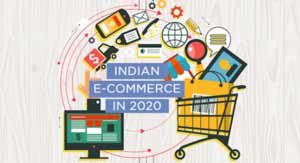Statistics show that e-traffic through mobiles will be 6 billion by 2020 and this will define the future of E-commerce.

The E-commerce market in India has recently garnered a lot of attention when global giant Walmart picked up a majority stake in India’s largest online retailer Flipkart. This is by far the world’s biggest eCommerce deal by absolute value and has set the future trends for more investments to follow in the coming years with a focus on niche categories like Fintech, Online Grocery and Furniture. This would also suggest that logistics and supply chain would get a major boost with the end customer being the actual gainer. Online shopping is set to get more convenient now and consumers should expect faster deliveries and competitive pricing of products and services.
There has been a huge spike in internet consumption in the last 5 years, aided by the competitive data tariffs across the country, e-commerce is fast gained momentum and has become an essential element of our daily life. With every passing year, newer platforms are sprouting up in the dotcom trading arena, thereby enlarging the size of the pie to a whole new level. Prompt customer-care service, after sale grievance handling, easy returns and attractive discounts have ensured that more and more customers are taking to online shopping now. Consumers today are not hesitant to order big-ticket items such as AC’s, Fridge, TV and even furniture online.
With the market perfectly poised, here are a few trends that are expected to flourish throughout 2018 and continue into 2020.
Same Day Delivery Will Become a Norm: The time between placing the order to receiving the delivery will reduce further and same day and in some cases delivery within a few hours will become a new norm. Customers hate the waiting time and one thing that tops their wish list when shopping online. Although this is a tough expectation to manage for the retailers, its implementation will guarantee more traffic at the shopping website than ever before. To ensure convenience and safety of shopper’s money, quick turnarounds and easy return, as well as refund policies, needs to be guaranteed.
Increased Use of Voice & Video Recognition: With artificial intelligence (AI) and technologies such as Alexa, Siri, and Google Home in place, consumers want to upgrade their online shopping experience and use voice instead of text. In some of the developed countries, one can easily give orders and check status at Dominos stalls through their voice. The online shopping channels across the globe are also making efforts to enable the same at the earliest. According to a study, the upcoming year will witness around 33% of consumers giving voice commands while shopping online.
More Visuals, Less Text Clutter: Shoppers prefer simple interface with easy accessibility and navigation while shopping online. If they feel the need to think about it and ask others, they simply prefer to move onto to other options as they lack the time and there is a plethora of options open for them. Customers prefer more of visuals and video options over text clutter as they are both easy to understand and be remembered. Hence, the future willsee the shopping portals with more simple home pages, striking visuals and extremely simple navigation bars with least of text clutter in the websites.
More of Sales Categories: At present, the e-commerce portals stay dominated by computer and consumer electronics, apparel & accessories, clothing, books, personal care, child care and other hobby items. No doubt, categories like food, beverage and gifting range which were earlier not a preference have now become a ripe opportunity for businesses that enter this arena. In the coming years, e-commerce will witness a boom in the demands of auto-parts, furniture & home furnishings, office equipment and supplies, medicine and healthcare products and many more.
Personalization: Customers nowadays don’t wish to see what everyone else is watching. Instead, they wish for something that has been customized for them only. This issue can be well tackled by the Artificial Intelligence and Machine Learning skills. The managers of the e-portals simply need to keep track of customers’ shopping behaviors and arrange for products that best suit these behavioral trends. This tailor-made experiences will better assist the sellers in the classification of the target market under various divisions based on age, gender, pay scale and so on. The result will be a much accurate and targeted marketing campaign that will boost the sales enormously.
Cross-Channel Marketing: Compared to traditional print and broadcasting mediums, digital media is a vast universe full of possibilities for the marketers to market their products & services and reach out to the target audience with various message delivery options available out there. However, restricting just to one channelof digital media for sharing the message with the audience is of no use. The marketers need to curate a master strategy that works out for all e-channels be it smartphones, tablets, desktops and other devices. As per statistics, e-traffic through mobiles will be 6 billion by 2020; this is an important information for the marketers skipping the mobile channels from their e-marketing strategies. It’s time for them to wake up and transform their present business plans into OmniChannel strategies lest they should be invisible to most of the probable audience and will be left behind in the competition.

